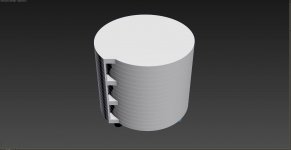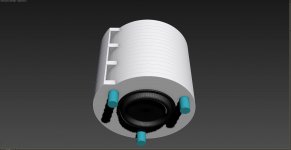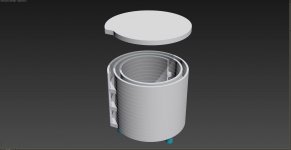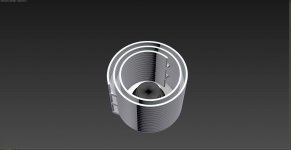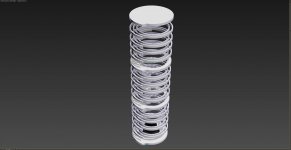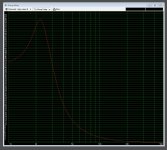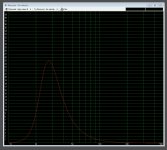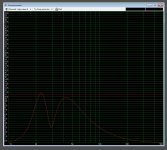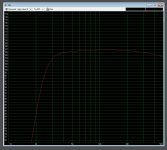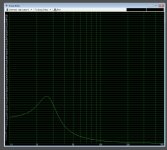ok ive got a design that sims well (i think) and has an interesting form.
want to just open it up to criticism before i spend any cash.
so, off we go:
its a small slot-ported cnc cut subwoofer, using the dayton reference HO 8" driver.
it has a chamber volume of 18 litres after subtracting driver displacement (more or less)
it has 3 slot ports each 2cm by 8cm, and 900cm long.
its made from stacked rings of 2cm thick mdf or plywood.
due to the bracing rings every 8cm, and the multiple layers between the chamber and the outside, i felt comfortable reducing wall thickness to 1cm.. thoughts?
rather than describing more, here are some screengrabs and winisd sim results:
want to just open it up to criticism before i spend any cash.
so, off we go:
its a small slot-ported cnc cut subwoofer, using the dayton reference HO 8" driver.
it has a chamber volume of 18 litres after subtracting driver displacement (more or less)
it has 3 slot ports each 2cm by 8cm, and 900cm long.
its made from stacked rings of 2cm thick mdf or plywood.
due to the bracing rings every 8cm, and the multiple layers between the chamber and the outside, i felt comfortable reducing wall thickness to 1cm.. thoughts?
rather than describing more, here are some screengrabs and winisd sim results:
3d screengrabs showing construction. layers would be glued, probably with thin threaded rods running through the height at intervals, clamping it all tight.
Attachments
winisd response graphs.. the group delay is mostly caused by 6th order butterworth highpass at 23 hz to keep excursion under control.
Attachments
please let me know your thoughts, im still quite a newbie.
the idea is a very small sub to help out some mission 780's in a large room. i was going to build two to even out response. run them both off a 250w per channel (or so) class d amp.
gotta be small, not ugly, and white, otherwise its not getting past the gatekeeper.
the idea is a very small sub to help out some mission 780's in a large room. i was going to build two to even out response. run them both off a 250w per channel (or so) class d amp.
gotta be small, not ugly, and white, otherwise its not getting past the gatekeeper.
oh, just to note, the 3d model is of a slightly older design with a 1.45m vent length. current design is 0.9m vent length, but ive not rebuilt the model yet.
- im concerned about group delay, becuse i need the highpass filter on there or it can only handle 25 watts before hitting xmax at low frequencies
i want something that sounds "tight" which, i understand, requires a low group delay.
i could always build sealed, but the response is nowhere near as nice.
- im concerned about group delay, becuse i need the highpass filter on there or it can only handle 25 watts before hitting xmax at low frequencies
i want something that sounds "tight" which, i understand, requires a low group delay.
i could always build sealed, but the response is nowhere near as nice.
Last edited:
one thing i dont understand.. acoustic stuffing in the chamber is supposed to be like making the box bigger.
however in winisd when i reduce the Qa value (advised to do this to simulate stuffing)
i get a reduction in low end extension -and- overall spl.. id have assumed the opposite, as increasing the box size improves performance in winisd.
however in winisd when i reduce the Qa value (advised to do this to simulate stuffing)
i get a reduction in low end extension -and- overall spl.. id have assumed the opposite, as increasing the box size improves performance in winisd.
My understanding is that stuffing doesn't actually make the box bigger in performance terms, but it changes the Q value downwards, meaning the natural response curve is less peaky.
I will await those with much more knowledge than me to correct what is probably an incorrect understanding... lol
Other than that, I love the design I reckon that would sell!
I reckon that would sell!
I will await those with much more knowledge than me to correct what is probably an incorrect understanding... lol
Other than that, I love the design
Stuffing will increase the apparent box volume, if spread out over the entire volume of the cabinet, without interrupting flow to and from the port too much.
Increase in apparent volume is easily 15 - 20% but at the cost of overall SPL. I've measured about 1 - 1.5 dB loss for optimum packing of a cabinet with fibrefill.
Neat cabinet!
Johan
Increase in apparent volume is easily 15 - 20% but at the cost of overall SPL. I've measured about 1 - 1.5 dB loss for optimum packing of a cabinet with fibrefill.
Neat cabinet!
Johan
ok but in this case, what is the benefit of stuffing? i get no lower extension improvement, and the spl goes down too.
i need to iterate the model a bit..., but it appears that a larger chamber (with correspondingly shorter port) would possibly end up smaller overall., whilst having higher spl and lower extension. i might possibly lose the nice "spiral/swissroll" structure if the port is too short though, which would affect the strength of the structure and require thicker walls..
i need to iterate the model a bit..., but it appears that a larger chamber (with correspondingly shorter port) would possibly end up smaller overall., whilst having higher spl and lower extension. i might possibly lose the nice "spiral/swissroll" structure if the port is too short though, which would affect the strength of the structure and require thicker walls..
- A cabinet that is 100 litres internal without stuffing, will behave (with stuffing) like it's a cabinet that is 120 litres internal. In other words, you can make the internal cabinet volume 20% smaller for the same tuning. Now it only needs to be 83.3 litres
- It will also reduce reflections, this is most apparent by smoothing of peaks and dips above 200 Hz
Johan
A reflex box like you are doing is usually only lined. A small box with low tuning does have a long vent. A bigger box may be smaller overall. Note that your sims are unlikely to be considering the extra damping of the vent caused by the high aspect ratio.
Much as am not a big fan of translam construction, this is a clever design.
Use plywood, not MDF.
dave
Much as am not a big fan of translam construction, this is a clever design.
Use plywood, not MDF.
dave
Translam construction eh? I had never heard that term before. Now i see its quite a common method. What are advantages/disadvantages? Off the top of my head, its wasteful of wood, and maybe strength is reduced in my case, with plywood, as the grain length will always be very short. - those rings will certainly be delicate until its glued together.
Im working towards some kind of sweet-spot of height/radius/port length.. Its a bit bigger than my initial design, but still very compact.
Im working towards some kind of sweet-spot of height/radius/port length.. Its a bit bigger than my initial design, but still very compact.
What are advantages/disadvantages? Off the top of my head, its wasteful of wood, and maybe strength is reduced in my case, with plywood, as the grain length will always be very short. - those rings will certainly be delicate until its glued together.
Yes, yes. MDF is even more likely to crack.
dave
Waste of wood is one of my main gripes with this construction method, but as your design enables a port that would otherwise be extremely difficult to achieve effectively without it, it's more justified than most.
One thing you might consider doing with the waste wood, is to construct a pair of sealed cylinder (or rounded rectangle - apparently cylinders are bad due to baffle edge diffraction) enclosures for 3" full range drivers from the middle rings. Then you'll have a negligible amount of waste and a very elegant 2.1 set. As someone else mentioned it's a design people might like to buy. Making a set out of it at negligible extra cost and cutting down your waste would make that considerably more likely.
I don't think you necessarily need a threaded bar running through it to be solid, and anyway it would spoil the aesthetic. Just clamp it while the glue is setting.
Since you have plenty of wood available on the inside, you might consider using a thicker cabinet construction once you get past the port. Obviously you'll sacrifice some notional elegance of design in doing this, but realistically no one will ever see the inside of the enclosure anyway. The port is braced so a thinner wall is less of a problem there, but I would increase the enclosure walls to double thickness at least. It'd add some extra heft to the enclosure as well which is always handy for a sub.
One thing you might consider doing with the waste wood, is to construct a pair of sealed cylinder (or rounded rectangle - apparently cylinders are bad due to baffle edge diffraction) enclosures for 3" full range drivers from the middle rings. Then you'll have a negligible amount of waste and a very elegant 2.1 set. As someone else mentioned it's a design people might like to buy. Making a set out of it at negligible extra cost and cutting down your waste would make that considerably more likely.
I don't think you necessarily need a threaded bar running through it to be solid, and anyway it would spoil the aesthetic. Just clamp it while the glue is setting.
Since you have plenty of wood available on the inside, you might consider using a thicker cabinet construction once you get past the port. Obviously you'll sacrifice some notional elegance of design in doing this, but realistically no one will ever see the inside of the enclosure anyway. The port is braced so a thinner wall is less of a problem there, but I would increase the enclosure walls to double thickness at least. It'd add some extra heft to the enclosure as well which is always handy for a sub.
Last edited:
(or rounded rectangle - apparently cylinders are bad due to baffle edge diffraction)
should i be considering this in my sub design? its relatively trivial to do a rounded rectangular form instead of cylindrical.. not quite so elegant, and a bit of a PITA to model in 3d keeping all the desired proportions.. also possibly might look more bulky, and the vent path wouldnt be so smooth...
i like the idea of using the offcut centres to make some small satellite speakers.. i was considering building a pair of rears and a centre speaker to turn my current stereo system into full 5.1
thanks for all the positive comments on the design, i am quite happy with it. im surprised ive not seen it before.. its a fairly logical extension of the boxes with the slot port wrapping round the outside.
what do people think of the sim results? does it all look ok? compare reasonably to other subs of a similar size/cost?
my main problem is i dont have the experience with simulations to know if my result is decent of not..
for reference its about 35 cm tall and about 35 cm diameter.
No, it only really applies to high frequencies.
Diffraction from baffle edges
The sims look good to me. The extension and SPL are both excellent for a compact hifi sub - with room gain applied you could see 115dB or more. That's one area you might want to think about, considering you're designing bespoke for a specific room. If you could run some tests with another sub and some basic measurement software, you could determine approximately what impact the acoustics of your room are going to have on the frequency response. If you're lucky you might be able to use an even smaller cabinet, but then the sub would be a bit tied to the room and might not work so well in other places.
It seems to make a very efficient use of space. It's not often that a cylinder is suitable for the lowest frequencies, as a cube just has so much more internal volume, so if you can get that sort of extension and SPL in a compact design and get away with a cylinder form that's a good sign.
The group delay is not as good as it could be, and will definitely be audible imo. That's the one thing that stands out. You might actually like that effect. Some people do (I like it personally, but there are limits). You could try modelling some different drivers just in case any of them perform substantially better, but if it's inherent to the box design I wouldn't worry too much.
Edit: I just noticed you said you want something that sounds tight. The group delay you've got there is not going to give you that at all. It'll be a distinctly loose sound.
I mean just to put it in some perspective I just simmed a 15 litre enclosure with the 10" Seas L26RO4Y, which is another driver that performs very well in compact designs. It doesn't come close to your design in lower bass extension without EQ, but if you EQ it up it can produce about 102dB at 30Hz, and it can produce as much as 110dB at 50Hz, 113dB at 75Hz so there's a lot of headroom in there.
The group delay with that design is 6.5ms at 30Hz, which is inaudible. 50ms+ is very audible.
Diffraction from baffle edges
The sims look good to me. The extension and SPL are both excellent for a compact hifi sub - with room gain applied you could see 115dB or more. That's one area you might want to think about, considering you're designing bespoke for a specific room. If you could run some tests with another sub and some basic measurement software, you could determine approximately what impact the acoustics of your room are going to have on the frequency response. If you're lucky you might be able to use an even smaller cabinet, but then the sub would be a bit tied to the room and might not work so well in other places.
It seems to make a very efficient use of space. It's not often that a cylinder is suitable for the lowest frequencies, as a cube just has so much more internal volume, so if you can get that sort of extension and SPL in a compact design and get away with a cylinder form that's a good sign.
The group delay is not as good as it could be, and will definitely be audible imo. That's the one thing that stands out. You might actually like that effect. Some people do (I like it personally, but there are limits). You could try modelling some different drivers just in case any of them perform substantially better, but if it's inherent to the box design I wouldn't worry too much.
Edit: I just noticed you said you want something that sounds tight. The group delay you've got there is not going to give you that at all. It'll be a distinctly loose sound.
I mean just to put it in some perspective I just simmed a 15 litre enclosure with the 10" Seas L26RO4Y, which is another driver that performs very well in compact designs. It doesn't come close to your design in lower bass extension without EQ, but if you EQ it up it can produce about 102dB at 30Hz, and it can produce as much as 110dB at 50Hz, 113dB at 75Hz so there's a lot of headroom in there.
The group delay with that design is 6.5ms at 30Hz, which is inaudible. 50ms+ is very audible.
Last edited:
well ive ordered two of the drivers 
anyway group delay was bugging me too.. unfortunately its mostly down to the highpass filter..
attached is a graph without the filter.
are there any other methods/filters to avoid firing the cone across the room under 25 hz, which dont introduce a massive group delay?
to be honest ive no understanding whatsoever of filter use/theory/design, or why they might introduce delay..
i only know enough to understand the "order" controls the rolloff of the filter..
i chose a 6th order butterworth at 22 hz as it chops off all the cone damaging stuff sharply under 25 hz, without hurting the extension above 25 hz.
should i be looking at other options?
EDIT: ok i read a bit, and changing to a 4th order filter helps a fair bit. does mean the cone goes into overexcursion at lower power, or i have to rais the highpass a few hz.. but since im not after an spl monster, and ill have two to play with, i can probably live with that.
since you mentioned the space efficiency of cubes, i might just have to look at a rounded cube version maybe i can get it smaller!
maybe i can get it smaller!
anyway group delay was bugging me too.. unfortunately its mostly down to the highpass filter..
attached is a graph without the filter.
are there any other methods/filters to avoid firing the cone across the room under 25 hz, which dont introduce a massive group delay?
to be honest ive no understanding whatsoever of filter use/theory/design, or why they might introduce delay..
i only know enough to understand the "order" controls the rolloff of the filter..
i chose a 6th order butterworth at 22 hz as it chops off all the cone damaging stuff sharply under 25 hz, without hurting the extension above 25 hz.
should i be looking at other options?
EDIT: ok i read a bit, and changing to a 4th order filter helps a fair bit. does mean the cone goes into overexcursion at lower power, or i have to rais the highpass a few hz.. but since im not after an spl monster, and ill have two to play with, i can probably live with that.
since you mentioned the space efficiency of cubes, i might just have to look at a rounded cube version
Attachments
Last edited:
To be fair I'm probably overstating the impact of group delay, as it's only really getting serious at about 35Hz. For almost all music program it won't impact on the tightness of the bass. The lower the frequency, the less able we are to perceive group delay, so it will be a subtle effect, noticeable with some content, but it'll be so subtle most people would need it pointed out to notice it.
My understanding of filters isn't much better than yours, but as a suggestion, you could rely on the fact that 99.99% of all program you play through it isn't going to have and sub-23Hz content, and for the insignificant amount of time it does play those frequencies, so long as it doesn't exceed xlim/xmech then you won't actually be damaging the driver.
Can you post the xmax graph without the crossover? Does it exceed xlim at any point?
The chance of playing an audio signal with significant content below 20Hz without purposefully doing so (with a tone generator or an audio signal designed for testing purposes) are so low, practically zero. If it only starts to exceed xlim at something like 15Hz at full volume, I would just say use it without a high pass.
My understanding of filters isn't much better than yours, but as a suggestion, you could rely on the fact that 99.99% of all program you play through it isn't going to have and sub-23Hz content, and for the insignificant amount of time it does play those frequencies, so long as it doesn't exceed xlim/xmech then you won't actually be damaging the driver.
Can you post the xmax graph without the crossover? Does it exceed xlim at any point?
The chance of playing an audio signal with significant content below 20Hz without purposefully doing so (with a tone generator or an audio signal designed for testing purposes) are so low, practically zero. If it only starts to exceed xlim at something like 15Hz at full volume, I would just say use it without a high pass.
- Status
- This old topic is closed. If you want to reopen this topic, contact a moderator using the "Report Post" button.
- Home
- Loudspeakers
- Subwoofers
- the "swissroll" compact 8" subwoofer
